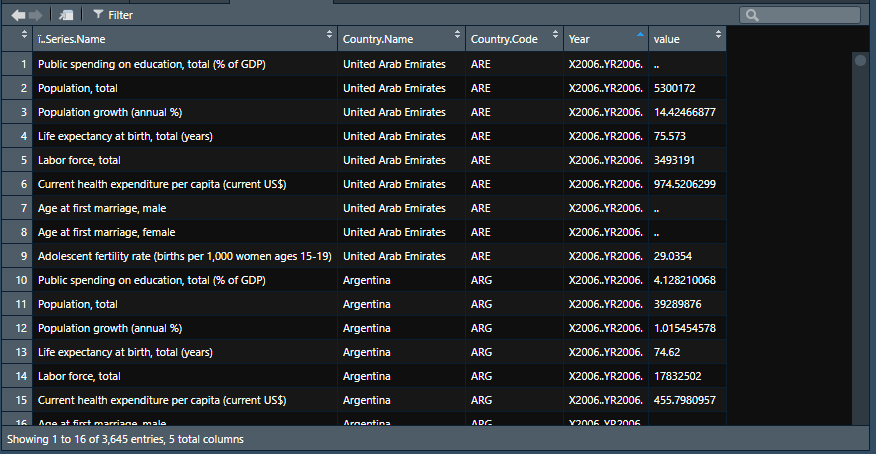The ~ï..Series.Name is the column/field where I have all the variables such as Adolescent fertility rate, public spending on education, and so on.
tibble::tribble(
~ï..Series.Name, ~Country.Name, ~Country.Code, ~Year, ~value,
"Adolescent fertility rate (births per 1,000 women ages 15-19)", "Argentina", "ARG", "X2006..YR2006.", "63.162",
"Adolescent fertility rate (births per 1,000 women ages 15-19)", "Argentina", "ARG", "X2007..YR2007.", "62.938",
"Adolescent fertility rate (births per 1,000 women ages 15-19)", "Argentina", "ARG", "X2008..YR2008.", "63.0638",
"Adolescent fertility rate (births per 1,000 women ages 15-19)", "Argentina", "ARG", "X2009..YR2009.", "63.1896",
"Adolescent fertility rate (births per 1,000 women ages 15-19)", "Argentina", "ARG", "X2010..YR2010.", "63.3154",
"Adolescent fertility rate (births per 1,000 women ages 15-19)", "Argentina", "ARG", "X2011..YR2011.", "63.4412",
"Adolescent fertility rate (births per 1,000 women ages 15-19)", "Argentina", "ARG", "X2012..YR2012.", "63.567",
"Adolescent fertility rate (births per 1,000 women ages 15-19)", "Argentina", "ARG", "X2013..YR2013.", "63.41",
"Adolescent fertility rate (births per 1,000 women ages 15-19)", "Argentina", "ARG", "X2014..YR2014.", "63.253",
"Adolescent fertility rate (births per 1,000 women ages 15-19)", "Argentina", "ARG", "X2015..YR2015.", "63.096",
"Adolescent fertility rate (births per 1,000 women ages 15-19)", "Argentina", "ARG", "X2016..YR2016.", "62.939",
"Adolescent fertility rate (births per 1,000 women ages 15-19)", "Argentina", "ARG", "X2017..YR2017.", "62.782",
"Adolescent fertility rate (births per 1,000 women ages 15-19)", "Argentina", "ARG", "X2018..YR2018.", "62.5654",
"Adolescent fertility rate (births per 1,000 women ages 15-19)", "Argentina", "ARG", "X2019..YR2019.", "62.3488",
"Adolescent fertility rate (births per 1,000 women ages 15-19)", "Argentina", "ARG", "X2020..YR2020.", "..",
"Age at first marriage, female", "Argentina", "ARG", "X2006..YR2006.", "..",
"Age at first marriage, female", "Argentina", "ARG", "X2007..YR2007.", "..",
"Age at first marriage, female", "Argentina", "ARG", "X2008..YR2008.", "..",
"Age at first marriage, female", "Argentina", "ARG", "X2009..YR2009.", "..",
"Age at first marriage, female", "Argentina", "ARG", "X2010..YR2010.", "24.6"
)
#> # A tibble: 20 x 5
#> ï..Series.Name Country.Name Country.Code Year value
#> <chr> <chr> <chr> <chr> <chr>
#> 1 Adolescent fertility rate (births ~ Argentina ARG X2006..Y~ 63.1~
#> 2 Adolescent fertility rate (births ~ Argentina ARG X2007..Y~ 62.9~
#> 3 Adolescent fertility rate (births ~ Argentina ARG X2008..Y~ 63.0~
#> 4 Adolescent fertility rate (births ~ Argentina ARG X2009..Y~ 63.1~
#> 5 Adolescent fertility rate (births ~ Argentina ARG X2010..Y~ 63.3~
#> 6 Adolescent fertility rate (births ~ Argentina ARG X2011..Y~ 63.4~
#> 7 Adolescent fertility rate (births ~ Argentina ARG X2012..Y~ 63.5~
#> 8 Adolescent fertility rate (births ~ Argentina ARG X2013..Y~ 63.41
#> 9 Adolescent fertility rate (births ~ Argentina ARG X2014..Y~ 63.2~
#> 10 Adolescent fertility rate (births ~ Argentina ARG X2015..Y~ 63.0~
#> 11 Adolescent fertility rate (births ~ Argentina ARG X2016..Y~ 62.9~
#> 12 Adolescent fertility rate (births ~ Argentina ARG X2017..Y~ 62.7~
#> 13 Adolescent fertility rate (births ~ Argentina ARG X2018..Y~ 62.5~
#> 14 Adolescent fertility rate (births ~ Argentina ARG X2019..Y~ 62.3~
#> 15 Adolescent fertility rate (births ~ Argentina ARG X2020..Y~ ..
#> 16 Age at first marriage, female Argentina ARG X2006..Y~ ..
#> 17 Age at first marriage, female Argentina ARG X2007..Y~ ..
#> 18 Age at first marriage, female Argentina ARG X2008..Y~ ..
#> 19 Age at first marriage, female Argentina ARG X2009..Y~ ..
#> 20 Age at first marriage, female Argentina ARG X2010..Y~ 24.6
Created on 2021-08-17 by the reprex package (v2.0.1)
So these rows are the ones I want to change from rows each into columns. (I have like 6 different data series or series names) so It would mean that I'd have 6 columns.
I tried your code and It's giving me an error.
